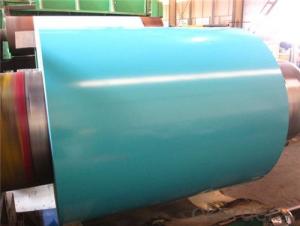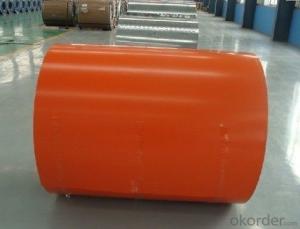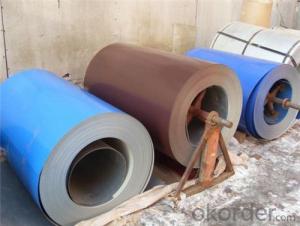Roof Tile Used Prepainted Steel Coil
- Loading Port:
- China Main Port
- Payment Terms:
- TT OR LC
- Min Order Qty:
- -
- Supply Capability:
- -
OKorder Service Pledge
OKorder Financial Service
You Might Also Like
Specification
1. Thickness: 0.3-0.8mm
2. Width: 914-1250mm
3. Inner Diameter: 508mm
4. Weight of Steel Coil: 3-15MT
5. Available Dipped Layer: 50-150g/m2
6. Surface Texture: Normal Coated
7. Type of coating structure: 2/1 Coat the top surface of the steel sheet twice, coat the bottom surface once, and bake the sheet twice.
8. Front Side Paint Thickness: 15-25μm (bottom paint+top paint)
9. Back Side Paint Thickness: 5-10μm
Mechanical Properties
1. Mechanical properties of base metals
Grade | Tensile Test | ||
Yield Strength MPa | Tensile Strength MPa | Elongation A80mm % ≥ | |
SGLCC | 140-350 | 270-500 | 22 |
SGLCD | 140-300 | 270-420 | 26 |
SGLCDD | 140-260 | 270-380 | 30 |
2. Common performance of front coating
(1). Thickness: ≥20μm
(2). Pencil Hardness: 2H
(3). 60° specular glossiness of coating: >60
(4). 180°bend: ≤3T
(5). Impact: ≥9J
(6). Salt Fog Resistant: ≥500h
(7). Color difference: <3ΔE


- Q: im buying a new guitar,, it has a built in tuner and its semi acoustic (can be plugged into an amplifier) ,, im trying to choose which strings are better ,, steel or nylon..?
- That's not an option Guitars are designed for either nylon or steel strings. They aren't interchangeable. Putting steel strings on a guitar designed for nylon strings WILL destroy the guitar. If you've already picked out the guitar you want, then you've already made your decision about nylon or steel.
- Q: How do steel coils contribute to fire resistance in buildings?
- Steel coils contribute to fire resistance in buildings in several ways. Firstly, steel coils have high melting points, which means they can withstand extremely high temperatures without losing their structural integrity. This helps prevent the collapse of the building during a fire. Additionally, steel coils have low thermal conductivity, meaning they do not readily transfer heat. This property helps to contain the spread of fire, preventing it from spreading rapidly within the building. Moreover, steel coils can be used to reinforce concrete structures, enhancing their fire resistance. By providing strength and stability to the building, steel coils play a crucial role in ensuring the overall fire safety of the structure.
- Q: What is the role of steel coils in HVAC systems?
- Steel coils are an essential component in HVAC systems as they act as heat exchangers, allowing for efficient transfer of heat between the refrigerant and the surrounding air. They help to cool or heat the air as it passes through the system, contributing to the overall temperature control and comfort in indoor spaces.
- Q: How are steel coils protected against scratches and damage?
- Steel coils are protected against scratches and damage through various methods such as applying protective coatings, using edge protectors, securely packaging them with appropriate materials, and ensuring careful handling during transportation and storage.
- Q: Where do I need hot galvanized steel coils and color coated rolls?
- The use of galvanized steel for color coated steel substrates, except zinc protection, organic coating on the zinc layer up covering the isolation effect, can prevent rusting steel, galvanized steel service life is longer, the coating steel plate galvanized steel long service life is 50%. However, the service life of the color coated plate with the same amount of zinc coating, the same coating and the same coating thickness will vary greatly in different regions and different parts.
- Q: How are steel coils welded together?
- Steel coils are typically welded together using one of two methods: either by resistance welding or by arc welding. In resistance welding, the coils are pressed together and an electric current is passed through them, generating heat and causing the coils to fuse together. Arc welding, on the other hand, involves the use of an electric arc that melts the edges of the coils, creating a molten pool. As the pool solidifies, the coils bond together, forming a strong weld. Both methods ensure a secure and durable connection between the steel coils.
- Q: How are steel coils protected during storage and transportation?
- Steel coils are protected during storage and transportation through various measures. Firstly, they are typically wrapped with a layer of protective material such as plastic or paper to shield them from moisture, dust, and other contaminants. Additionally, steel coils are often stored in a controlled environment, such as a warehouse, to prevent exposure to extreme temperatures and weather conditions. During transportation, they are secured using specialized equipment such as steel coil racks, which prevent movement and minimize the risk of damage. These protective measures ensure the integrity and quality of steel coils throughout their storage and transportation processes.
- Q: This question gets beat to death from what ive seen online but im going to ask it since im searching for a few new knives. The question is as the titles states what is the best steel for a general purpose knife? I plan on buying several different types of knives, Folders, fixed blades, ect. I will carry them around with me all the time for basically anything i can think of to use it for. The reason i ask this question here is because looking online everyone has a differnt veiw. Some say stainless is too soft while others say carbon will chip and is more brittle. Even looking at just a single type of steel, carbon fort instance everyone has a different opinion as to whats best leaving me kind of lost for what i should get. Maybe the better word would be What is a good general purpose steel?. Any advice is much appreciated!!!!
- Do you want apples or oranges? It's that kind of question. Here's my opinion. For large blades (over 6) 5160 or L-6 done properly makes a nearly unbreakable knife. I once pulled my 65lb vice out of the work bench with an 8 L-6 blade. As carbon content goes up edge holding increases but at the cost of overall strength. For smaller blades I prefer O-1 and 52100, these steels have about twice the edge holding as 5160 but cannot pass the 90deg bend test without breaking. 1095 is a fine steel, I prefer to make damascus from it, but when I do make a blade I want to show a temper line as this steel will do it well. Then we get into high alloy, D-2 is about as balanced as they come and for a smaller blade is second to none save the CPM steels. The CPM steels are very expensive and like the homogonous steel come in many alloys. As far as a chipping edge, that's more an indication of improper heat treating than anything. Carbon steel has more strength and edge holding potential than stainless. D-2 has enough chromium to be somewhat stainless but not beyond the threshold that grain growth becomes an issue. One last thing, the grind is important. The popular hollow grind cuts easily but is weak at the edge because it is thin. A flat grind has more mass and done properly cuts as well as the hollow. The convex is the strongest and is best suited for chopping or a polished edge to push through the material.
- Q: in broken steel can you to missions and get things like the dog, you previously didnt do/get in fallout 3?
- I wish you people would put your questions in the right place.
- Q: I wanted to know what is steel fabricating?
- Steel Fabricating/or Steel Fabricators is just a fancy way of saying that they sell steel products and a variety of related services. Thomas steel products has a wide range of steel products and services, from Windsor Republic Door Dist, Tie Wire, Steel Doors Frames, Snap Ties, S Parker Hardware Distributor, Reinforcing Steel Detail Drawings Avail, Rebar Fabrication, o_O.
Send your message to us
Roof Tile Used Prepainted Steel Coil
- Loading Port:
- China Main Port
- Payment Terms:
- TT OR LC
- Min Order Qty:
- -
- Supply Capability:
- -
OKorder Service Pledge
OKorder Financial Service
Similar products
Hot products
Hot Searches
Related keywords




























